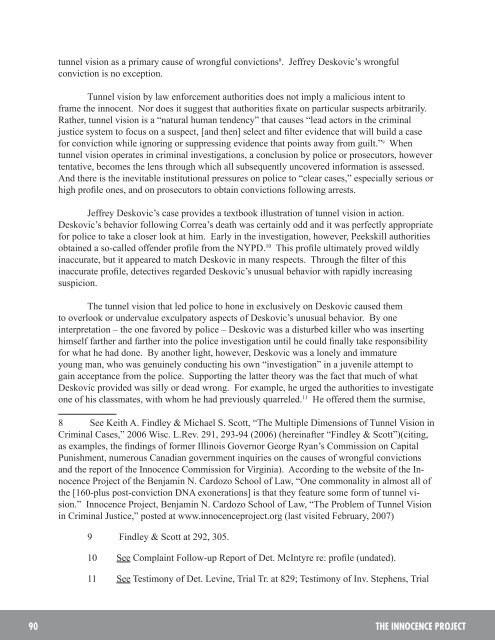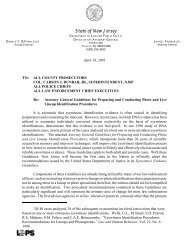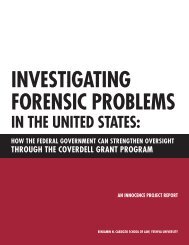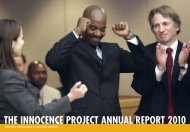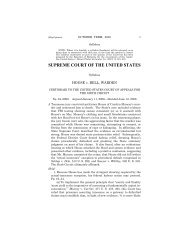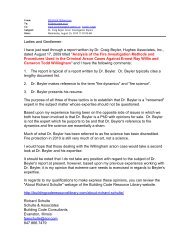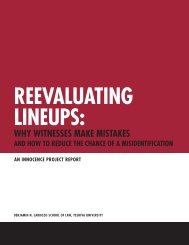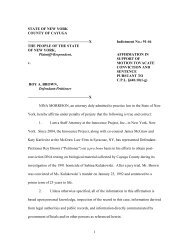Lessons Not Learned - The Innocence Project
Lessons Not Learned - The Innocence Project
Lessons Not Learned - The Innocence Project
Create successful ePaper yourself
Turn your PDF publications into a flip-book with our unique Google optimized e-Paper software.
tunnel vision as a primary cause of wrongful convictions 8 . Jeffrey Deskovic’s wrongful<br />
conviction is no exception.<br />
Tunnel vision by law enforcement authorities does not imply a malicious intent to<br />
frame the innocent. Nor does it suggest that authorities fixate on particular suspects arbitrarily.<br />
Rather, tunnel vision is a “natural human tendency” that causes “lead actors in the criminal<br />
justice system to focus on a suspect, [and then] select and filter evidence that will build a case<br />
for conviction while ignoring or suppressing evidence that points away from guilt.” 9 When<br />
tunnel vision operates in criminal investigations, a conclusion by police or prosecutors, however<br />
tentative, becomes the lens through which all subsequently uncovered information is assessed.<br />
And there is the inevitable institutional pressures on police to “clear cases,” especially serious or<br />
high profile ones, and on prosecutors to obtain convictions following arrests.<br />
Jeffrey Deskovic’s case provides a textbook illustration of tunnel vision in action.<br />
Deskovic’s behavior following Correa’s death was certainly odd and it was perfectly appropriate<br />
for police to take a closer look at him. Early in the investigation, however, Peekskill authorities<br />
obtained a so-called offender profile from the NYPD. 10 This profile ultimately proved wildly<br />
inaccurate, but it appeared to match Deskovic in many respects. Through the filter of this<br />
inaccurate profile, detectives regarded Deskovic’s unusual behavior with rapidly increasing<br />
suspicion.<br />
<strong>The</strong> tunnel vision that led police to hone in exclusively on Deskovic caused them<br />
to overlook or undervalue exculpatory aspects of Deskovic’s unusual behavior. By one<br />
interpretation – the one favored by police – Deskovic was a disturbed killer who was inserting<br />
himself farther and farther into the police investigation until he could finally take responsibility<br />
for what he had done. By another light, however, Deskovic was a lonely and immature<br />
young man, who was genuinely conducting his own “investigation” in a juvenile attempt to<br />
gain acceptance from the police. Supporting the latter theory was the fact that much of what<br />
Deskovic provided was silly or dead wrong. For example, he urged the authorities to investigate<br />
one of his classmates, with whom he had previously quarreled. 11 He offered them the surmise,<br />
8 See Keith A. Findley & Michael S. Scott, “<strong>The</strong> Multiple Dimensions of Tunnel Vision in<br />
Criminal Cases,” 2006 Wisc. L.Rev. 291, 293-94 (2006) (hereinafter “Findley & Scott”)(citing,<br />
as examples, the findings of former Illinois Governor George Ryan’s Commission on Capital<br />
Punishment, numerous Canadian government inquiries on the causes of wrongful convictions<br />
and the report of the <strong>Innocence</strong> Commission for Virginia). According to the website of the <strong>Innocence</strong><br />
<strong>Project</strong> of the Benjamin N. Cardozo School of Law, “One commonality in almost all of<br />
the [160-plus post-conviction DNA exonerations] is that they feature some form of tunnel vision.”<br />
<strong>Innocence</strong> <strong>Project</strong>, Benjamin N. Cardozo School of Law, “<strong>The</strong> Problem of Tunnel Vision<br />
in Criminal Justice,” posted at www.innocenceproject.org (last visited February, 2007)<br />
9 Findley & Scott at 292, 305.<br />
10 See Complaint Follow-up Report of Det. McIntyre re: profile (undated).<br />
11 See Testimony of Det. Levine, Trial Tr. at 829; Testimony of Inv. Stephens, Trial<br />
90 THe InnoCenCe PRoJeCT


